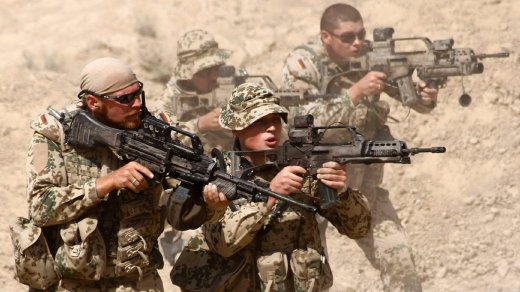This time last year, the defense industry was fraught with angst about its future. With the withdrawal from Iraq completed in 2011 and the war in Afghanistan drawing to a close, U.S. defense budgets were cut by $500 billion for the ten year period following 2011. In Canada the defence budget were also cut by 10%, with additional cuts anticipated. At this time, ISIS was not yet a serious threat, Russia was still a member of the G8 and many thought the Syrian conflict would resolve itself as in Egypt or Libya.
Yet here we are, only 12 months later, gearing up for what may be another long and difficult war. U.S. House Representative Peter King said last week, “This is not just bombing a mountainside or securing a dam. This is a war that could go on for another 10, 15 years. And to do that we’re going to have to recalibrate our thinking toward defence, and realize that we have to be on a wartime footing when it comes to spending.”
The world has learned a difficult lesson from its past failures of not intervening or leaving too soon, causing a vacuum of power that enables extremism to flourish. This time, the coalition knows the result of a half-hearted war: a galvanized enemy, a weakened state, and a strong likelihood that history will repeat itself again. As nations around the world prepare to once again ask already drained and war-fatigued tax payers to fund another ideological war, it is interesting to note who will profit from the death, destruction and chaos.
 Last week President Obama outlined a plan to intensify airstrikes in Iraq. Additionally, it seems the government will try to rely entirely on contractors instead of U.S. troops for ground combat: the U.S. Army posted a notice last month seeking contractors for services that fall within the existing mission of the “Office of Security Assistance-Iraq”, which is to help build institutional capacity of Iraq’s security ministries. These contactors would be involved in a variety of activities from administration, contracting, training management, logistics, communications, planning and operations, infrastructure management and intelligence, the notice stated. Contractors note that this represents a business opportunity for an industry that has shrunk in recent years from 242,000 contractors in 2008 to 66,000 in 2014. One U.S. military contractor working in Iraq said “I can tell you the contractor-expat community is abuzz thinking this will lead to more work. We expect a much larger footprint than [we have] right now”. Although the drawdown of the war occurred several years ago, share prices in the defense industry continued to rise. Lockheed Martin, for example, has seen its share price nearly double since 2010. The top 5 U.S. defense companies continue to profit by $2-3 billion annually. However, the industry’s profitability has often been at the expense of workers who lost their jobs. Other downsides to the withdrawal were the loss of skilled worked and the erosion of engineering and research capabilities. For companies like Northrop Grumman, which gets some 86 percent of its revenue from the U.S. government, the renewed war will prove to be a boon to their employees, capabilities and future vitality.
Last week President Obama outlined a plan to intensify airstrikes in Iraq. Additionally, it seems the government will try to rely entirely on contractors instead of U.S. troops for ground combat: the U.S. Army posted a notice last month seeking contractors for services that fall within the existing mission of the “Office of Security Assistance-Iraq”, which is to help build institutional capacity of Iraq’s security ministries. These contactors would be involved in a variety of activities from administration, contracting, training management, logistics, communications, planning and operations, infrastructure management and intelligence, the notice stated. Contractors note that this represents a business opportunity for an industry that has shrunk in recent years from 242,000 contractors in 2008 to 66,000 in 2014. One U.S. military contractor working in Iraq said “I can tell you the contractor-expat community is abuzz thinking this will lead to more work. We expect a much larger footprint than [we have] right now”. Although the drawdown of the war occurred several years ago, share prices in the defense industry continued to rise. Lockheed Martin, for example, has seen its share price nearly double since 2010. The top 5 U.S. defense companies continue to profit by $2-3 billion annually. However, the industry’s profitability has often been at the expense of workers who lost their jobs. Other downsides to the withdrawal were the loss of skilled worked and the erosion of engineering and research capabilities. For companies like Northrop Grumman, which gets some 86 percent of its revenue from the U.S. government, the renewed war will prove to be a boon to their employees, capabilities and future vitality.
In addition, the plan to intensify airstrikes means manufacturers of manned and unmanned aircraft, along with producers of missiles and munitions, are set to profit from the conflict. Since June the U.S. has struck the region with over 150 missiles at a cost of $600 million. The major players in the operation have included drone makers Northrop Grumman and General Atomics, as well as missile makers Lockheed Martin, Raytheon, Boeing and General Dynamics. Satellite imagery and GPS technology will also play a key role in pinpointing enemy locations and movements. Estimates put the cost of the war at $15 million per day, or $5.5 billion per year.
One positive outcome of the conflict could be to “reverse the trend of tapering investments in the technology” says Mark Gunzinger, former Deputy Assistant Secretary of Defense. Unmanned aerial vehicles, or UAVs, have many potential applications, from agriculture to science. The growth in investment can stimulate the R&D needed to move the technology to the next level. Another advancement to look for is the accuracy of strikes. In the past few years, the ratio of civilian deaths caused by drone strikes has been 17%. In conventional warfare, between 20%-80% of casualties are civilians. However, there is always room for increased accuracy- and hopefully the accumulated experience using airstrike technology will lead to improved outcomes.
Five weeks into the war, it is impossible to predict the length or scale of the defense effort, or the growth in power of the enemy. It is clear, however, that though the world watches the developments unfold in horror, the defense industry is breathing a sigh of relief.
hana maqsood filza maqsood




